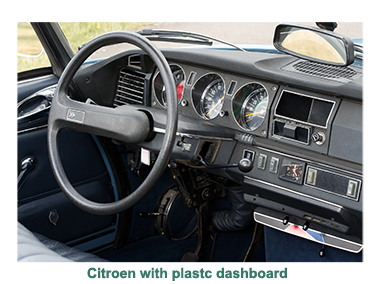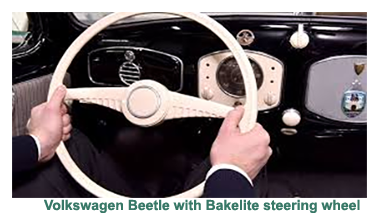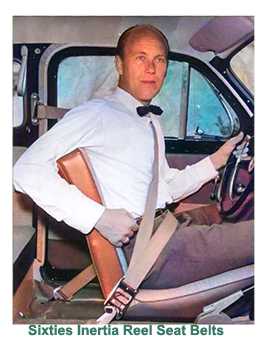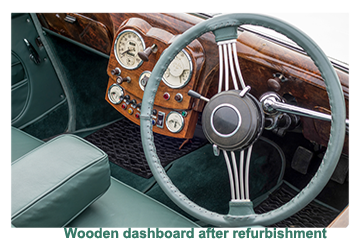 You can assume that a classic car that has been around for at least the last sixty years- if not more, will be sorely in need of what is known as a "from the botton up" restoration,
You can assume that a classic car that has been around for at least the last sixty years- if not more, will be sorely in need of what is known as a "from the botton up" restoration,
During the years that the vehicle was in frequent use it's interior will have been very well used.
After hundreds if not thousands of hours on the road with the driver and passengers using its facilities, while a long and varying list of personal possessions and even a few animals were transported in it during the years the vehicle was in use, the signs of its hectic life will be well in evidence.
That's the reason why anyone appraising a Fifty of Sixties classic car being considered for restoration should go armed with digital camera to capture and document all repairs and renovations that will need to bring the vehicle's interior back to a reasonable working condition.>
A classic car interior restoration covers several stages, which are only remotely interlinked. They run as follows:- Instruments and gauges.
- The dashboard and steering wheel
- Wooden trim
- Seat Belts and other safety features.
- In-car entertainment.
Only when an instrument or gauge has been removed from the dashboard and taken to a restoration specialist will a detailed estimate of costs and time scale involved. The critical gauges that will need to be in perfect order are - oil, temperature and fuel.
If the oil and water gauges are not operating or providing false readings, results can be catastrophic to engine. Fuel gauges, inaccurate, could cause light damage filter but certainly a lot of embarrassment and inconvenience.
![]()
That is why the first priority when restoring a classic car interior is to find a company that can handle the restoration and repair of all of the gauges so that the vehicle can be driven with confidence.
How much will be required s to be spent on restoring a complete set of instruments will vary, depending on how many gauges were fitted and their current state of repair. There are several options available that the restorer will have to contemplate considering authenticity and adhering to a budget needing to be evaluated.
Once the gauges and clocks have been sent off for repair, the next stage in the interior restoration process should be the vehicle dashboard and the rest of the interior trim, particularly the door panels.
If the veh icle being restored is in the luxury class, it is more than likely that the dashboard and trim were produced in solid wood or possibly a veneer. Middle of the road vehicles and compact were fitted with plastic trims.
icle being restored is in the luxury class, it is more than likely that the dashboard and trim were produced in solid wood or possibly a veneer. Middle of the road vehicles and compact were fitted with plastic trims.
The costs for restoring vehicles with wooden dashboards and trims will be much higher than those with plastic, especially if the wooden trim is veneered and not solid wood. Veneers are liable to crack and become discoloured over the years and, even worse, exposed to damp conditions while in storage.
Once again, the experts will need to be called to restore the dashboard and trim it to its formal glory. If the wood used was solid, then the costs of renewing should be less- as long as the vehicle was stored in dry condition and was not exposed to dampness.
In such cases, sometimes all that is required is a complete resurface – not on overly expensive process, although certainly one that should be handled by an experienced craftsman.
![]()
Once frowned upon, plastic or polyurethane dashboards are nowadays a restorer's dream as they can be repaired quickly and inexpensively. Even if they are too far gone to be repaired, there is a wide selection of aftermarket dashboard available for most mass-produced models of the Fifties and Sixties, which can be easily fitted.
One of the focal point of any car's interior is its steering wheel.
The first steering wheels fitted were based on a metal frame covered with solid wood. As the years went by, aluminium replaced solid metal. Solid wood was replaced by pre-formed plywood coated by a thick layer of veneer- usually to match the rest of the vehicle's interior trim.
In the pos t-war years, most steering wheels were produced using synthetic materials, thermoplastics or Bakelite, a compressing phenol resin under high pressure till it formed a rock-hard compound.
t-war years, most steering wheels were produced using synthetic materials, thermoplastics or Bakelite, a compressing phenol resin under high pressure till it formed a rock-hard compound.
Their outstanding electrical insulation capability characterises thermosetting plastics such as Bakelite and the ease they can be shaped, making them a favourite of car manufacturers in the US and Europe during the Fifties and Sixties.
Be it metal, wood or Bakelite, renewing a steering wheel is again a job best left to the professionals. While there are very few specialist steering wheel restorers around these days, they can be readily traced in digital or printed media or at trade shows.
It may be even possible to source a reconditioned or part used if the original steering wheel can be salvaged. In the era of 3D printing, any item can be reproduced and will be as tough and authentic as the original.
![]()
Seat belts have fitted in private cars for well over a century, but it was only during the Sixties that awareness of in-car safety became a consideration. The number of vehicles on the road was growing considerably and with it the number of car accidents.
Early safe ty belts took their design mainly from those used in commercial aircraft based around either lap straps or shoulder harnesses and rarely both.
ty belts took their design mainly from those used in commercial aircraft based around either lap straps or shoulder harnesses and rarely both.
The first significant breakthrough in car safety belt design came in 1958 from Volvo designer Nils Bohlin who developed the first three-point safety belt, fitted as standard on all Volvo produced from that year onwards.
 After many years of research, Bohlin had recognised the importance of an effective restraint system using static seat belts with fixed buckles, which were both comfortable and easy to use.
After many years of research, Bohlin had recognised the importance of an effective restraint system using static seat belts with fixed buckles, which were both comfortable and easy to use.
The main drawback with fixed seatbelts were that they were costly. Towards the end of the Sixties, "inertia-reel" seatbelts began to make an appearance, which were both inexpensive but ensured that the driver and passengers were allowed sufficient freedom of movement during their journey.
Despite the developments, seat belt s still failed to capture the motoring public's imagination, and it was only intervention from the various European Vehicle Licensing Authorities in the Sixties and onwards that made it compulsory for manufacturers to install fit three-point belts in the front outboard positions came three years later.
s still failed to capture the motoring public's imagination, and it was only intervention from the various European Vehicle Licensing Authorities in the Sixties and onwards that made it compulsory for manufacturers to install fit three-point belts in the front outboard positions came three years later.
If the classic car was produced before 1965 and seat belts were not fitted at the point of manufacture, there is no legal requirement to fit them but only common sense to do so.
While some fairly primitive radios were fitted in private cars from the Thirties onwards, it was only during the mass production explosion of the car industry that occurred during the Fifties and Sixties that several significant developments in in-car entertainment were introduced.
The first breakthrough came in the early Fifties with the introduction of the AM radio band followed shortly after by FM.
Progress was rapid in the early Fifties, with West German audio giants Becker introducing the first car radio with an AM/ FM permutation.
By the early Sixties, in-car transistor radios were becoming the norm, with trailblazer Becker becoming the first to offer a "solid state" radio with no vacuum tubes.
The next stage in in-car development came in 1965 with the introduction of the Eight-Track Tape Player.
Anyone restoring a Fifties or Sixties classic have their choices. If there already is a radio or stereo fitted in the car, the chances are that it will no longer be in working order.
If authenticity is the order of the day, then the restorer must bite the bullet and pay whatever it takes to get the radio back in working order. They may get lucky and source a similar model in working order, either privately or from one of the specialist shops that deal in secondhand car radios.
is the order of the day, then the restorer must bite the bullet and pay whatever it takes to get the radio back in working order. They may get lucky and source a similar model in working order, either privately or from one of the specialist shops that deal in secondhand car radios.
The last option is to a sound system with the appearance of being vintage but provides the best in-car entertainment available today.
Visit an in-car entertainment specialist who will be happy to advise on the best system that will meet particular requirements concerning the audio quality.
Even if the terminology were unheard of when the car was first produced, today's in-car entertainment specialist would be capable of integrating them into a classic vehicle using techniques that will make the new/old radio totally unobtrusive.
In car entertaiment and communication systems have developed so rapidly in the last few years to include such driver friendly accessoris as navigational systems and even a voice recognition phone system allowing the driver to carry out a number of functions while remaining totally in focus.
 Restoring a classic car's interior is a project for the multi-tasker, that can make for a major investment, eating up a fair chunk of any restoration budget.
Restoring a classic car's interior is a project for the multi-tasker, that can make for a major investment, eating up a fair chunk of any restoration budget.
Although, if and when everything falls into place, the results will be spectacular.
int 4



